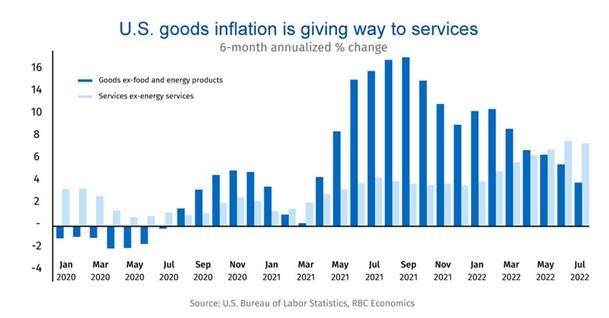The overriding narrative of 2022 has been that inflation is way too high and central bankers must work aggressively to rein it in. To put it in perspective, expectations when we entered 2022 were for U.S. Fed rate hikes of 0.75% in 2022, which is 1.50% less than the rate hikes we have already seen year-to-date (2.25%) with at least another 1% of hikes likely before the end of 2022.
Raising interest rates to tame inflation rests on the premise that inflation is a function of supply and demand. If there is not enough supply of something and demand is rising, the price of that item will rise to balance out supply and demand. Why? Because demand is in part a function of price – that is – the more expensive something becomes, the less demand there will be for it. We would note that there are items in which demand is relatively less responsive to price changes (referred to as “inelastic”) such as food and medicine and items in which demand is very responsive to price changes (referred to as “elastic”) such as luxury goods. The Fed is generally worried about elastic demand as it relates to inflation because this is the type of demand that can be impacted by changes in interest rate policy.
So how does raising rates lower inflation? Raising interest rates rests on a second premise that higher borrowing costs will tend to cool demand for stuff. Think of it in terms of buying a car. If you can buy a car with a 0.9% 7-year loan (which you could have back in 2021), you might be willing to stretch a little for the fancy Lincoln with rich Corinthian leather seats. But, if that interest rate rises to 4.9%, you probably are going to either 1) become more price conscious – let’s go with the pleather seats; or 2) opt out of buying a car all together until either prices come down or borrowing costs go down.
And guess what? The actions of the Fed (and other central banks) is starting to work:

Let’s first focus on the dark blue bars in the chart above, which encompasses goods inflation (ex the stuff that is inelastic and the Fed cannot impact all that much) over a 6-month period. As you can see, the dark blue bars have come down pretty sharply, from about 15% a year ago to less than 4% today. Now, 4% is still way too high (2% is the ultimate target), but things are definitely moving in the right direction.
But alas, there is a second problem, which is the light blue bars. The pandemic touched off a crisis in goods. Supply chains shut down at the same time that demand for stuff soared. This increase in demand was driven by a variety of factors, but the two main ones were: 1) government stimulus gave lots of folks a lot of disposable cash and 2) lockdowns meant you couldn’t spend money on going to the movies, or out to eat or on vacation, so you had even more disposable cash to spend on stuff.
But this script has now shifted. After 2-years of varying lockdowns, the economy is now largely open and there is an awful lot of pent-up demand for vacations and restaurants and a variety of other services-related industries. Thus, while goods-related inflation has dropped sharply and is likely to continue to do so, services-related inflation has been rising sharply (following the same supply/demand dynamic as goods did back in 2020/21). This has been made worse by a lack of available labor for services-related jobs, which has made services less available and increased the costs of those services that are available.
So where does this lead? Inflation is likely to continue to come down toward the target rate of 2%. However, because of the countervailing impact of rising services demand vs. falling goods demand, the path to 2% is likely to stretch well into 2023. Thus, expectations are that the U.S. Federal Reserve and the Bank of Canada will continue to aggressively raise interest rates into the end of 2022 in order to provide a backdrop in 2023 in which demand continues to cool.
Market Update
After a strong rally from early July through mid-August, the stock market has given back some of the gains over the past two-weeks. The aforementioned discussed inflation/interest rate dynamic is at the heart of the selloff as investors continue to grapple with what the ultimate end up point will be for interest rates. Most stocks are now pricing in a mild to moderate U.S. recession, which we think is probably close to the base case for what the U.S. economy will experience over the next 12-months. That said – we would continue to note that the U.S. job market remains far from recessionary with today’s August job numbers (+315k with the bulk in services-related industries) offering further evidence of this.
